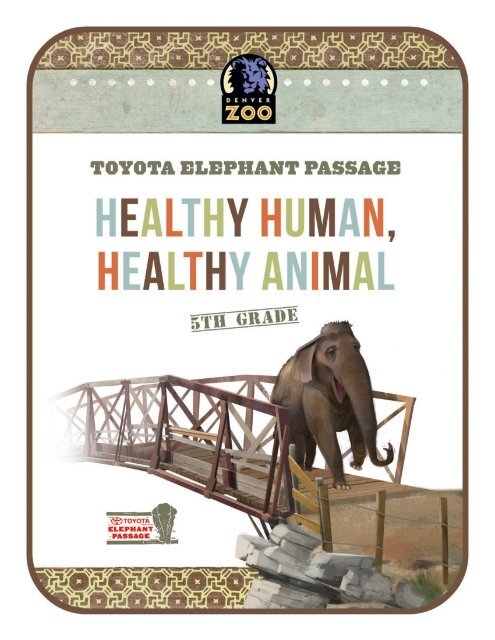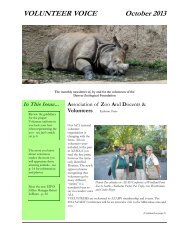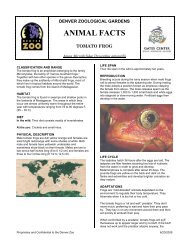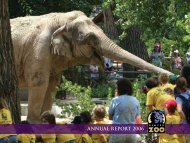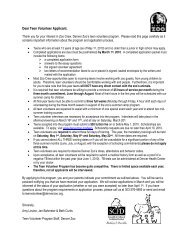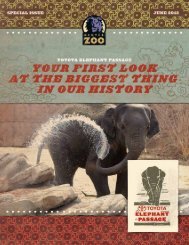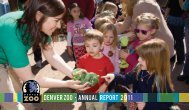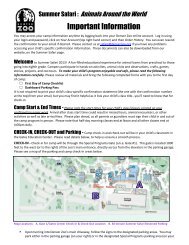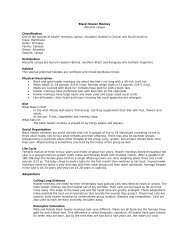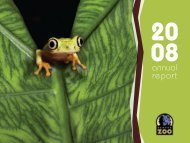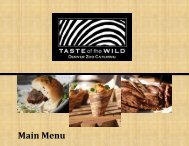Download Printer Friendly PDF - Denver Zoo
Download Printer Friendly PDF - Denver Zoo
Download Printer Friendly PDF - Denver Zoo
Create successful ePaper yourself
Turn your PDF publications into a flip-book with our unique Google optimized e-Paper software.
<strong>Denver</strong> <strong>Zoo</strong>Toyota Elephant Passage Field Trip Discovery Unit5 th Grade – HEALTHY HUMAN, HEALTHY ANIMALOverviewUnit Overview: Learn about the intentions of this Field Trip Discovery Unit; the guiding question andColorado Academic Standard that provide the framework for this unit; the final project thatconnects to the before‐visit, at‐the‐zoo and after‐visit activities; and how long this unit will take toimplement.Table of Contents: See how the before‐visit, at‐the‐zoo and after‐visit activities connect and buildup to a final project.Best Practices in Field Trips: Understand how to best structure and utilize field trip experiences inorder to enhance and support your students’ learning.AcknowledgementsOverview of the Field Trip Discovery UnitWho should use this unit?The Healthy Human, Healthy Animal Field Trip Discovery Unit has been intentionally designed forColorado fifth grade students visiting <strong>Denver</strong> <strong>Zoo</strong>’s Toyota Elephant Passage exhibit. Depending on eachdistrict or school’s curriculum, as well as the students’ learning level, this unit can be adapted for othergrade levels.What academic standards does this unit focus on?The activities in this unit are focused on the following Colorado Academic Standard Grade LevelExpectations (GLEs) for fifth grade:Science 2.1: All organisms have structures and systems with separate functions.Science 2.2: Human body systems have basic structures, functions and needs.Additionally, many other activities in this unit secondarily focus on other Colorado Academic GLEs,including those from Reading, Writing and Communicating; Visual Arts; and Social Studies. Refer to eachactivity for specific alignment.What is the guiding question?In this unit, your students will explore the guiding question “How can the management of healthyhuman body systems be compared and contrasted to the management of healthy animal bodysystems?” within the context of the Toyota Elephant Passage exhibit, which is home to 16 species ofvertebrate animals and many species of plants. The exhibit is a perfect living laboratory for students tobegin to explore concepts of how the management of healthy body systems is similar and differentbetween humans and animals.1
o Use peer socialization to enhance student engagement during the field tripo Encourage individual and group inquiry and learningo Integrate multiple disciplinesChances for students to engage in age‐appropriate science and social studies dialogueEnglish and Spanish chaperone field trip guides to support chaperones in their important roleof continuing the learning goals during the field trip experienceStudent and teacher orientation videos to help orient teachers, students and chaperones tothe zoo before their visitTable of ContentsBefore‐Visit Activities1) Pre‐Assessment: Understand students’ entry knowledge and skills about the content throughdiscussion and activities.2) Introduction to Final Project and Field Trip: Introduce the final project and field trip experienceto the students.3) Building Knowledge Activities: Expand student knowledge through lessons, videos, books andactivities.4) Extension Learning‐ Loan Libraries: Reserve a free loan library featuring unit‐specific books.5) Getting Ready to Go to <strong>Denver</strong> <strong>Zoo</strong>: Teachers and students use <strong>Denver</strong> <strong>Zoo</strong> resources to becomefamiliar with what to expect on your field trip in terms of logistics, coming prepared, and whatanimals and cultural objects you might see and learn about. Students determine questions toask at the zoo to help with their projects.At‐the‐<strong>Zoo</strong> Activities1) General Guidelines: Understand logistics and proper behavior to ensure a smooth and safe fieldtrip.2) Extension Learning‐ Education Programs at <strong>Denver</strong> <strong>Zoo</strong>: Consider registering in advance for anon‐site zoo class or tour to give your students an up‐close encounter with live animals and thechance to learn from zoo experts.3) Chaperone Guide: Help chaperones guide students through the exhibit, the zoo, activities anddiscussions.4) Student‐Led Activities: Students record data and observations related to their final projectduring their visit.After‐Visit Activities1) Reflection Activity: Allow students to digest and absorb their field trip through a reflectionactivity.2) Extension Learning‐ Loan Libraries: Reserve a free loan library featuring unit‐specific books.3) Final Projects and Presentations: Tie it all together through the creation and presentation ofstudents’ final projects.4) Teacher Evaluation: Help <strong>Denver</strong> <strong>Zoo</strong> improve our teacher resources by giving us feedback.3
Best Practices in Field TripsLearning outside the classroom is important. Informal settings, like zoos and museums, providespace for all learners to engage with ideas and authentic resources. According to the NationalResearch Council’s 2009 Report Learning Science in Informal Environments: People, Places andPursuits, informal learning environments can provide students with experiences that evokeexcitement, interest and motivation to learn.Based on research related to learning in informal settings, like zoos, the following areconsidered “best practices” for increasing learning on field trips. <strong>Denver</strong> <strong>Zoo</strong> used thesepractices in the development of the Toyota Elephant Passage Field Trip Curriculum:1. Structure the field trip – Teachers and students should work together to structure anddefine learning goals and outcomes of the field trip experience (so that students knowwhat is expected of their behavior and learning while away from school), but timeshould be allowed during the field trip for students to engage in “free‐choice” learningand social time.2. Orient students, teachers and chaperones to the site before the visit – The newnessof the setting can detract from students’ conceptual and affective learning if novelty ofthe setting is either very strong or absent all together. Spend time before the visitpreparing students and chaperones for what they will experience on the bus and at thezoo.(Teachers may prepare themselves by visiting the zoo before their visit—for free—by presenting their school ID to the Guest Services staff at the main entrance.)3. Develop prior knowledge before the visit – Students learn the most from an exhibitwhen they already have some understanding of the concept being explored on the trip.4. Integrate students’ personal interests, motivations and agenda on the trip – Allowingstudents to have some say in what they learn on the field trip will increase theirmotivation to learn because it will be personally relevant.5. Prepare the chaperones – Chaperones serve two main functions: to ensure groupsafety and to facilitate learning. Providing chaperone training prior to the zoo visit,engaging them in dialogue, and/or providing them with simple resources ahead of timecan greatly enhance the role they serve.6. Take advantage of the social nature of a field trip – Students want to be social on fieldtrips; take advantage of this opportunity for group learning where students and adultsshare discoveries and experiences with others, as well as engage in content discourse.7. If worksheets are used, keep them concept‐oriented – One research study conductedat Monterey Bay Aquarium found that worksheets can interfere with the socialinteraction and possible learning of student groups. If teachers want to useworksheets, it is best to use worksheets that are less based on “scavenger hunts”where students essentially cross items off a list, and instead are more conceptoriented.Keep worksheets focused on a single concept; allow for student choice, useopen‐ended questions, include fewer questions, encourage observation, refer toobjects more than labels, and encourage talk among group members.8. Integrate before‐visit and after‐visit experiences with the field trip experiences – Aschool field trip begins as preparation in the classroom and ends in some form offollow‐up. The extent and quality of both strongly influence the learning potential ofthe entire field trip experience.4
National Research Council. (2009). Learning Science in Informal Environments: People, Places and Pursuits. Committee on LearningScience in Informal Environments. Philip Bell, Bruce Lewenstein, Andrew W. Shouse, and Michael A. Feder, Editors. Board onScience Education, Center for Education. Division of Behavioral and Social Sciences and Education. Washington, DC: The NationalAcademies Press.AcknowledgementsThank you to the following companies, groups and individuals who have helped makethis resource possible!This Toyota Elephant Passage Field Trip Discovery Unit is a product of <strong>Denver</strong> <strong>Zoo</strong>’sEducation and Volunteer Services Department.WritersRebecca Wahlberg CoonMarley Steele‐InamaStaff ReviewersAngela BarberBeth CurtisAmy LearSarah MetzerMicaela MuñizBrad ParksTracey PattersonKarie PhillipsJenna Rose RiggenTrisha SejasSara WeisbergClassroom Teacher Feedback and ReviewersRebecca Archuleta (Teller Elementary)Amanda Mae Astry (Goldrick Elementary)Linda Young Atencio (Stukey Elementary)Susan Austin (Farrell B. Howell School)Rebecca Blauw (Strasburg Elementary)Kalen Crane (Sagebrush Elementary)Amber Evans (Joyful Mission Preschool)Kelsey Feltes (Johnson Elementary)Melissa Free (Turnberry Elementary)Ali Graham (Witt Elementary)Nicola Hodkowski (Goldrick Elementary)Sarah Kaeding (Goldrick Elementary)Angela Maez (Kunsmiller Creative Arts Academy)Rebecca McGoldrick (Shepardson Elementary)Eileen Patrick (STEM Magnet Lab School)Patricia Pluta (Goldrick Elementary)Sandra Sandler (Willow Creek Elementary)Lisa Self (Dalton Elementary)Jessie Sheldon (Maxwell Elementary)Melissa Snyder (Goldrick Elementary)Julie Stewart (Challenge To Excellence CharterSchool)Linda Weiss (Place Bridge Academy)Judith Witten (Goldrick Elementary)5
oprompt them to. Or if you would like students to work in groups, you can use this blankhuman systems chart (see Appendix).If the students have trouble coming up with some of the systems, see if they can guess thesystems by giving them some clues about the systems’ functionality or where in the bodythe systems’ organs are found. Continue prompting them until you have created a chart (ormultiple pieces of chart paper) that represent most or all of the systems below. If theycannot think of all of these systems, you may add them yourself or leave them out until theBuilding Knowledge Activities.Body SystemSkeletalMuscularDigestiveRespiratoryCirculatoryReproductiveNervousDermal (skin)ExcretoryImmuneEndocrineHealthy Human Systems2. Discuss Body System Functionality (Approximate time: 15 minutes)o Ask students to create small groups of 2–4 people. Assign each group one human bodysystem.o Ask the students to discuss within their group what parts make up their body system andwhat their body system does. What are its main functions? If students have not yet learnedabout particular body systems, reassure them that it is okay if they do not know all of theanswers right now and that you will continue learning about them as a class. Students willlikely already have a better intuitive understanding of some systems more than others (e.g.,they will probably know more about the skeletal system than the endocrine system).o Create a new column (or half of the chart paper) labeled “Parts and Function” next to thecolumn of body systems on the class chart. Have students come fill in the space next to theirassigned body system on the class chart. You may ask them to write their ideas as completesentences or as more bulleted thoughts.o Encourage them to think critically about the purpose of different body parts. Do not correctmisconceptions yet; see if they can identify misconceptions in the Building KnowledgeActivities before you correct them.• What body system do you think the teeth belong to? Why? Can a body part belongto more than one system?• What about the skin? What is its function?• What system do you think the eyes belong to? Whyo Have each group verbally share with the rest of the class their ideas about their bodysystem’s parts and functions. Ask the rest of the class if they believe that anything should beadded or changed to the functions of that body system. Your chart should now look similarto this shortened example:7
necessary to take additional time developing this conceptual understanding before movingon to the next activities.Introduction to Final Project and Field TripObjectives Teachers verbally introduce the purpose and scope of this unit of study to the students. Students begin to understand that they will be conducting classroom activities and taking a fieldtrip to <strong>Denver</strong> <strong>Zoo</strong> in order to create a final project related to the study topic.NOTE: More in‐depth details of the classroom activities, preparations for the field trip and the finalproject will be addressed in their own sections. These explanations are meant to mentally preparestudents for deeper investigations later on.Materials and ResourcesNoneActivities1. Introduce Final Project (Approximate time: 7 minutes)o Explain that students will be studying how the management of healthy body systems ofanimals can be compared and contrasted to managing healthy systems of humans. Explainthey will be conducting a series of activities and explorations that will help them develop afinal project.o Explain that part of the exploration will be to take a field trip to <strong>Denver</strong> <strong>Zoo</strong>. On the fieldtrip, the students will be scientists, observing animals in Toyota Elephant Passage andkeeping track of ways that the animals’ body systems stay healthy. During the trip, they willchoose one animal from Toyota Elephant Passage and one type of zoo employee to featurein their final project, a Healthy Human, Healthy Animal book.o Explain that in the days following their field trip, they will complete their final projects backat school:• Healthy Human, Healthy Animal (illustrated book or digital creation): Based ontheir observations in Toyota Elephant Passage as well as their research about howhumans and animals maintain healthy body systems, students will create books ordigital creations comparing human and animal body systems and how to keep themhealthy. Books will be written from the point of view of a real or imagined zooemployee and will highlight a selected animal from Toyota Elephant Passage. Thehuman character will narrate how they take care of their own body systems andhow animals, with the help of zoo staff, take care of their body systems. Explain thatafter they complete their projects, they will be presenting them and reading thestories to their class, other classes, younger/older “buddies” and/or their familiesand friends. You may choose to have students write, draw and collage to create theirHealthy Human, Healthy Animal illustrated books. You may choose to have the students develop their projects as a digitalstory in the form of a digital book, presentation or video.2. Introduce the Field Trip Experience (Approximate time: 5 minutes)o Inform students that they will be visiting <strong>Denver</strong> <strong>Zoo</strong> in the near future. The trip willinclude a visit to the Toyota Elephant Passage exhibit, where they will have the9
Activities; Healthy Animal Systems charts (see Appendix); research materials (student Internet accessrecommended); teacher assessment chart(see Appendix)Activities1. <strong>Denver</strong> <strong>Zoo</strong> Videos, Suggested Books and Websites (Approximate time: 10 minutes–multiple hours)o To get the students acquainted with the animals in Toyota Elephant Passage and the waysthat the exhibit helps keep their body systems healthy, show students <strong>Denver</strong> <strong>Zoo</strong> onlinevideos.o Refer to the list of suggested books and websites (see Appendix) and select some books toshare with the students to help them understand how the management of healthy systemsof the animals in the exhibit can be compared and contrasted to that of managing healthysystems of humans. You may look for these books in your school or local library, or checkout a free loan library box (see Appendix) from <strong>Denver</strong> <strong>Zoo</strong> that includes the suggestedbooks. Refer to the suggested websites to research human and animal body systems fromdifferent sources.o Facilitate a class discussion about some of the similarities and differences between bodysystems and healthy living of humans and animals in Toyota Elephant Passage.2. Update Healthy Human Systems Chart (Approximate time: 15 minutes)o Ask students to conduct further research about the human body system they reported on inthe Pre‐Assessment Activities. Have students expand on their ideas in the Healthy HumanSystems Chart based on anything new they learned from the books, videos or Internetresearch. Have them use a different color of marker than the Pre‐Assessment activity ordraw a line beneath the first section so that you can see which ideas are new. The revisedcharts should look similar to this. Additions are shown in bold text.Healthy Human SystemsBody Parts and FunctionHealthy Activities That Help the SystemSystemSkeletal Made of bones Drinking milk and eating calcium‐rich foods helps Creates a frame andmy bones become strongerfoundation for the body Playing jump rope helps my bones become Allows body parts to bestrongerconnected Taking vitamins helps my bones become stronger Skull protects brain Swimming helps relieve pressure from my jointsMuscular Made of muscles Running helps get blood and oxygen to my Allows the bones and body musclesto move Helping my parents plant a garden helps my Some muscles (like those muscles grow strongerin our heart and stomach)move without us thinking Lifting heavy things helps my muscles growstrongerto help the body performits duties Drinking lots of water helps my muscles get bloodand oxygen and keeps them from cramping too We control how we move muchother muscles like those in Taking vitamins can help repair my musclesour legs and arms Playing outside makes my leg and arm musclesstronger and helps my heart muscles pump bloodto the rest of my body11
Which two cardinal directions could we go to get to Toyota Elephant Passage exhibit oncewe enter the zoo?What animals might we see in the pools in Toyota Elephant Passage?How many animal exhibits can you find in between Predator Ridge and the Giraffes Building?Trace your finger between Toyota Elephant Passage and the way you would go to get backto the bus. Which animals and areas would you pass on your way?How many bathrooms can you find? Which one is closest if you are on the boardwalk nearthe biggest pool in Toyota Elephant Passage? Which one is closest if you are near the bridgeof Toyota Elephant Passage?If someone scraped their knee and needed First Aid, where would they go?Can you find any open grassy places that look like good picnic spots?What times are the animal demonstrations at the McGrath Family Amphitheater in ToyotaElephant Passage?What times are the Sea Lion Shows?When students are looking at the map of Toyota Elephant Passage, ask questions like: What animals do you see? Can you find any animals that are smaller than a tapir? What is the name of the bridge? What is the largest building? If you were standing in front of the elephant shown on the map, how would you get to theclosest bathroom? What building is in between the Schoelzel Family Village and the Anschutz FoundationGibbon Islands? Where is the longest swimming area?Using Google Maps, look at a satellite view of <strong>Denver</strong> <strong>Zoo</strong>. Find Toyota Elephant Passage within the view of <strong>Denver</strong> <strong>Zoo</strong>. How is the satellite imagesimilar to and different from the graphic map provided here? How are they orienteddifferently? Why is it helpful to look at both a satellite image of the real space and a graphicrepresentation of the space? When would it be more helpful to use one instead of the other? What else can you find in the zoo using the “street view” feature in Google Maps and movingthe “person” around?Learn about Toyota Elephant Passage: The Exhibit (Approximate time: 10 minutes)1. If your students have not watched the <strong>Denver</strong> <strong>Zoo</strong> animal care videos, show students thevideos to help acquaint them with the exhibit before their visit.2. Share information from <strong>Denver</strong> <strong>Zoo</strong>’s website on the exhibit (see Appendix)—what animalsthey will see and how the exhibit is thematically designed. You can even explore images of kidfriendlygraphics on the “For Kids” section of the website. (see Appendix)Develop Student Questions (Approximate time: 10 minutes)1. Remind students about the goals of their final project: Healthy Human, Healthy Animal(illustrated book or digital creation).2. Ask students what they want to learn about while they are at <strong>Denver</strong> <strong>Zoo</strong> that would help themwith their final projects.14
3. Provide students with the <strong>Zoo</strong> Research Notes (see Appendix) addressed in the At‐the‐<strong>Zoo</strong>Activities section. If you prefer, you or your students can create their own format of researchnotes or use a science notebook to record questions.4. Have students write down their questions on their <strong>Zoo</strong> Research Notes (see Appendix) in thebox provided for their questions, or write on whatever notes they will bring with them to thezoo.15
At‐the‐<strong>Zoo</strong> Activities OverviewGeneral Guidelines: Understand logistics and proper behavior to ensure a smooth and safe fieldtrip.Extension Learning‐ Education Programs at <strong>Denver</strong> <strong>Zoo</strong>: Consider registering in advance for an onsitezoo class or tour to give your students an up‐close encounter with live animals and the chanceto learn from zoo experts.Chaperone Guide: Help chaperones guide students through the exhibit, the zoo, activities anddiscussions.Student‐Led Activities: Students record data and observations related to their final project duringtheir visit.At‐the‐<strong>Zoo</strong> ActivitiesThe following objectives, standards and materials/resources connect to the entire at‐the‐zooexperience.Objectives Students explore the guiding question of this Field Trip Discovery Unit—How can themanagement of healthy human body systems be compared and contrasted to the managementof healthy animal body systems?—in an authentic environment where they will be able toobserve and engage with the content through direct observations of live animals, talking withexperts (e.g., staff and volunteers) and participating in a variety of activities. Teachers and chaperones provide guidance, facilitate discussions, and document studentquestions and choices related to final projects.Colorado Academic StandardsScience: 2.2Reading, Writing and Communicating: 1.1, 1.2, 2.2Materials and ResourcesPreparation materials and guidelines for teachers and chaperones, chaperone guides in English (seeAppendix) and/or in Spanish (see Appendix), proper clothing, a water bottle, snacks/lunch, <strong>Zoo</strong>Research Notes (see Appendix) and clipboards for students to write on at the zoo (optional)General GuidelinesFor teachers:Field Trip Planning Guide (see Appendix)Unit‐specific Chaperone Overview (see Appendix) <strong>Download</strong> a “Field Trip Planning Guide” to get facts about field trip logistics. Decide if you aregoing to add any extension learning field trip opportunities (see Appendix) such as a zoo class orguided tour. If you are going to do a self‐guided field trip, learn how to register for a self‐guided field trip.(see Appendix)16
<strong>Denver</strong> <strong>Zoo</strong> offers free visits to teachers to prepare for their field trip. <strong>Download</strong> and print acoupon (see Appendix); then present your school ID at Guest Services for your free entrance.Additional guests joining you will need to pay full admission or use their membership card toenter.Learn more about how to utilize Toyota Elephant Passage during a field trip by attending aprofessional development opportunity such as teacher workshops (see Appendix) about relatedtopics or training sessions in Toyota Elephant Passage about how to best use your Field TripDiscovery Unit. Workshops and trainings are usually offered on evenings and weekends; someare free with pre‐registration and others require fees. Sign up for our Educator e‐bulletin (seeAppendix) to keep up with <strong>Denver</strong> <strong>Zoo</strong>’s opportunities and resources for teachers.Make sure you have one chaperone for every 10 students. Teachers are consideredchaperones.Clearly communicate to your chaperones zoo rules, learning expectations and meetingtimes/locations for lunch, programs and departure. You can write this information into yourunit‐specific Chaperone Guides.You can download a unit‐specific chaperone overview (see Appendix) that includes links to theorientation videos, zoo map and the grade level chaperone guide to prepare chaperones beforethe field trip. You might even consider having a meeting with them before the field trip to helpthem understand their role in ensuring safety and facilitating learning and discovery.For students:<strong>Zoo</strong> Research Notes (see Appendix) Wear comfortable clothing and good walking shoes. Bring everything with you in your backpack when you leave the bus (water bottle, food,sweater, etc.). Know who your chaperone is and stay with your group. Make sure you understand the zoo rulesas well as what your teacher expects you to be learning and observing during your trip. Please do not feed any of the animals at the zoo, including the peacocks. They all have special diets andwhen we feed them our food, it can make them sick. Please do not chase or taunt the animals, bang on the windows of their enclosures, or throwanything into their enclosures. The zoo is their home. Record questions, observations and discoveries in your <strong>Zoo</strong> Research Notes (see Appendix) orother notebooks.For Chaperones:Unit‐Specific English chaperone guide (see Appendix)Unit‐Specific Spanish chaperone guide (see Appendix)Unit‐specific Chaperone Overview (see Appendix)General Chaperone Guide (see Appendix) Your job is to ensure student safety and to facilitate learning. You do not need to be an expert, butyou should ask students questions related to what they are exploring. The more you can encourageyour students to explore, observe and share discoveries with each other, the more they will learn. Look in your unit‐specific Chaperone Guide (English or Spanish (see Appendix)) to get an overviewof guidelines as well as appropriate questions to ask your students. <strong>Download</strong> the generalChaperone Guide (see Appendix) from the <strong>Denver</strong> <strong>Zoo</strong> website for a complete listing of rules,guidelines and logistical information. The unit‐specific chaperone overview (see Appendix) includeslinks to the orientation videos, zoo maps and the grade level chaperone guides.17
Get to know your group of students by first name and make sure they know what to call you. Count your students regularly. Make sure you have all of them with you at all times. Please do not feed any of the animals at the zoo, including the peacocks. They all have special dietsand when we feed them our food, it can make them sick. Please do not chase or taunt animals. Please do not bang on the glass or throw anything into theirenclosures. Please help your group to be respectful of all of the animals you see; the zoo is theirhome. Know when and where you are supposed to be for lunch, departure and any scheduled programs. Please confirm with the teacher first before taking students on any ride (e.g., train) or into a giftshop. If you are going to visit the gift store, allot the appropriate amount of time. Read the questions in your unit’s Chaperone Guide ahead of time to understand what questionsyou can ask to facilitate learning among your students during your field trip.Extension Learning: Education Programs at <strong>Denver</strong> <strong>Zoo</strong>Immerse your students in the animals, ecosystems and culture of Toyota Elephant Passage with zooeducators as your guides. Consider booking one of these related programs for your field trip visit at<strong>Denver</strong> <strong>Zoo</strong> to provide your students with a unique experience that deepens their learning at the zoo.Advance registration is required.<strong>Zoo</strong> Ed‐venture Treks, Classes, Assemblies and Guided Tours: Make your visit even more memorablewith unit‐aligned programs that feature inquiry‐based exploration, dynamic animal encounters,“biofact” animal specimens and engaging education with expert zoo educators. For detailed informationon a program that specifically relates to this unit, as well as information about how to book a program,visit our website (see Appendix). It is best to book these programs as early as possible.Chaperone GuideChaperone Guide in English (see Appendix)Chaperone Guide in Spanish (see Appendix)This two‐page guide is intended to be printed front and back to provide chaperones with a one‐pagefolded guide to help them ensure student safety and facilitate student learning during the zoo field trip.Student‐Led Activities<strong>Zoo</strong> Research Notes (see Appendix) The following <strong>Zoo</strong> Research Notes (see Appendix)are intended for students to complete duringtheir field trip to the zoo. Remind students and chaperones to help each other explore theexhibit to find answers to their own questions and to make observations in their <strong>Zoo</strong> ResearchNotes (see Appendix) about habitats in Toyota Elephant Passage. You may also choose to createyour own form of research notes or have students record observations in science notebooks. If your students and/or chaperones have the ability to take pictures that might help themdevelop their projects, encourage them to snap some photos of habitats in Toyota ElephantPassage.18
After‐Visit Activities OverviewReflection Activity: Allow students to digest and absorb their field trip through a reflection activity.Extension Learning‐ Loan Libraries: Reserve a free loan library featuring unit‐specific books.Final Projects and Presentations: Tie it all together through the creation and presentation ofstudents’ final projects.Teacher Evaluation: Help <strong>Denver</strong> <strong>Zoo</strong> improve our teacher resources by giving us feedback.After‐Visit ActivitiesReflection Activity: Discussion, Update Charts and Pair‐ShareObjectives Students reflect on their field trip experience through discussion and activities to better digestand remember what they learned, felt and discovered. Students take on the point of view of both the zoo employee and the animal that they willfeature in their illustrated books and create a “share circle” to verbally share how eachcharacter keeps their body systems healthy. Students update their Healthy Animal Systems Charts from the Before‐Visit activities based onany new ideas or information. Teachers better understand what and how their students have learned.Colorado Academic StandardsScience: 2.1, 2.2Reading, Writing and Communicating: 1.1, 1.2Materials and ResourcesCharts from the Before‐Visit Activities; name tags (2 per student); markersActivitiesThe day after the field trip:1. Look Back Discussion (Approximate time: 10 minutes)o Facilitate a discussion with students to assess their experience at the zoo, how their ideasmay have changed and how their knowledge has grown. You might revisit the ideas theyexpressed in the Before‐Visit Activities including the Healthy Systems Charts for humans andanimals. Consider asking questions such as:• What do you know now about how animals and humans’ body systems are similarand different that you did not know before we went to the zoo? How did you learnthat?• In Toyota Elephant Passage, what clues did you find related to how <strong>Denver</strong> <strong>Zoo</strong>helps animals’ body systems stay healthy?• Outside of Toyota Elephant Passage, did you see any clues about how <strong>Denver</strong> <strong>Zoo</strong>keeps other animals’ body systems healthy?19
• What is similar and different about how animals keep their bodies healthy and howyou do?• Which animals did you enjoy observing the most? Why? Which animal did youchoose to focus on for your final project?• Which zoo jobs seem the most interesting to you? Why? Which zoo staff orvolunteers did you interact with? Which zoo job did you choose to focus on for yourproject?2. Update Charts (Approximate time: 8 minutes)o Ask students to update their Healthy Animal Systems Charts based on the class discussion toreflect any changes in their thoughts.3. Share Circle (Approximate time: 10–30 minutes)o Facilitate a “Pair‐Share” in which students will take turns speaking from the point of view oftheir chosen animal and that of their chosen zoo staff person in order to compare andcontrast how the healthy management of their body systems is similar and different.o Instruct each student to take two name tags. Keep the two name tags distinct from eachother by using different colored tags or different colored markers to write names. On onename tag, each student will write the type of zoo staff person they will use in their story(zookeeper, veterinarian, exhibit designer, educator or volunteer). On the other name tag,each student will write the type of animal they will use in their story (e.g., Asian elephant orfishing cat).o Have students find a partner and have each student decide who will be Student A and whowill be Student B.o First, Student A will talk continuously for 1–2 minutes from the point of view of their animalabout how it stays healthy. You may choose to be more specific and have them talk aboutwhat things they do to help keep a particular body system healthy (e.g., circulatory ordigestive). Student B will simply be a good listener.o Then, Student B will talk continuously for 1–2 minutes from the point of view of theirselected zoo staff person about how he/she stays healthy. If you instructed Student A tofocus on a particular body system, have Student B focus on comparing and contrasting theways that he/she keeps that same body system healthy to the way that Student A’s animalkeeps that system healthy.o Now repeat the process but have Student B talk from the point of view of their animal andStudent A talk from the point of view of their zoo staff person. If you are having studentsfocus on particular body systems, choose a new system for this rotation.o Below is an example of how a full Pair‐Share cycle might look:a) Student A (Johnny) tells Student B (Sally) about how Johnny’s animal (cloudedleopard) keeps its circulatory system healthy.b) Student B (Sally) tells Student A (Johnny) about how Sally’s zoo staff person (anexhibit designer) keeps his/her circulatory system. Student B compares andcontrasts the human’s healthy activities to those of the animal.c) Student B (Sally) tells Student A (Johnny) about how Sally’s animal (Asian smallclawedotter) keeps its dermal system healthy.d) Student A (Johnny) tells Student B (Sally) about how Johnny’s zoo staff person (aneducator) keeps his/her dermal system healthy. Student A compares and contraststhe humans’ healthy activities to those of the animal.20
oYou may repeat this Pair‐Share process as many times as you would like to, having studentsfind a new partner every time, but always talking from the perspectives of their selectedanimals and zoo staff persons. If you have the time and students are engaging in the activity,you may choose to repeat the process in order to talk about each body system.3. Teacher Assessment (Approximate time: 10 minutes, mostly completed while students areworking)o While students are engaging in the Reflection Activities, add notes to your teacherassessment chart (see Appendix) to record students’ conceptual understanding of thestructure, function and health of body systems in humans and animals.Extension Learning: Loan LibrariesConsider utilizing one of these unique opportunities from <strong>Denver</strong> <strong>Zoo</strong> either before or after your fieldtrip to provide your students with an enhanced learning experience.Loan LibrariesLoan libraries contain incredible unit‐specific children’s literature and nonfiction books. Theseresources can be reserved for up to two weeks. They must be reserved in advance and require a$25 refundable deposit. You may pick up your loan library at the zoo or have it shipped to yourschool for an additional fee. For detailed information on a loan library that specifically relates to thisunit, as well as information about how to reserve this resource, visit our website (see Appendix). It isbest to reserve loan libraries as early as possible.Final Project and Presentation: Healthy Human, Healthy Animal (illustrated bookor digital creation)Objectives Students write a story from the point of view of a zoo staff person about maintaining healthybody systems of themselves and of an animal from Toyota Elephant Passage. Students turn their stories into an illustrated book or digital creation (digital book, presentationor video) based on your parameters and the resources available to you. Students will present their books to other classes, older or younger “buddies” and/or theirfriends and families. The final project serves as a summative assessment for the teachers about the students’ gains inknowledge and skills, as well as changes in attitudes or feelings, as a result of the curriculum.Colorado Academic StandardsScience: 2.1, 2.2Reading, Writing and Communicating: 1.1, 1.2, 3.1, 3.2, 3.3, 4.1, 4.2Visual Arts: 2.2, 3.1, 3.2, 3.3Materials NeededPaper and pencils; class charts from the Before‐Visit Activities; research resources; markers, coloredpencils, construction paper, glue, other craft materials for creating illustrations; computers to type on,use for research and look for images (ideal but not required)21
Activities1. Explain (Approximate time: 5 minutes)o Inform students that they will be writing their stories from the point of view of the zoo staffperson they selected (zookeeper, veterinarian, exhibit designer, educator, or volunteer). Thestudents will use the charts and research that the class created before the trip as well as theobservations they made during their field trip. Encourage students to check the accuracy oftheir peers’ research and consider the reliability of the source of the information as they arewriting their own stories. The stories should be rooted in the facts they collected frominformational texts and at‐the‐zoo observations, but students are encouraged to use theirimagination and creativity to create a fictional story using these facts. Ask them if they canthink of any books that use this strategy.o Students may use the real names of individual animals in Toyota Elephant Passage or theycan make up new names for their characters.2. Create Story Rough Drafts (Approximate time: multiple hours)o Provide students with ideas/prompts for sections of their stories, and ask them to create arough draft of their story. Explain that this will be a rough draft, but after they are satisfiedwith their story, they will create a neater, more formal final draft in the form of anillustrated book or digital creation.• You may choose to use daily writing prompts to pose different questions to helpstudents develop their stories during regularly scheduled class writing time.o Below in bold are possible story prompts that could be used to create outlines and roughdrafts. In italics are short examples.• An acrostic poem about their animal. (Written by Jessica, a zookeeper, about Vinh,a northern white‐cheeked gibbon) Vinh is very acrobatic; she brachiates overhead, swinging across the vines. Islands offer leaves for her to eat and places for her to walk. Now she grooms her partner Jing‐Chi. He is quite shy, but she helps her playmate be more adventurous.• Information about the zoo staff person and introduction to story. (I am Jessica. Ihave been a zookeeper at <strong>Denver</strong> <strong>Zoo</strong> for 9 years. I primarily work with primates likethe northern white‐cheeked gibbons. As we are primates too, it is amazing to look atsimilarities and differences between humans and these furry “lesser apes.” Today Iam going to share with you how my body systems are similar and different fromVinh, my favorite animal in Toyota Elephant Passage. I will also share with you thesimilar and different things we do to keep our systems healthy.)• Information about the animal. (This is Vinh, a 22‐year‐old female northern whitecheekedgibbon who moved to <strong>Denver</strong> <strong>Zoo</strong> last year…)• A story comparing and contrasting the body systems and healthy maintenance ofthose systems of the human zoo staff person and the featured animal. The humancan narrate the story, or the human and the animal can take turns “talking” abouttheir body systems and ways they keep those systems healthy. Students might create their stories using a very structured format toaddress each body system as in the example below.1) Description of human body system (e.g., human’s skeletal system);2) Comparative description of animal body system (e.g., animal’sskeletal system);22
3) Ways that the human character keeps that body system healthy;and4) Ways that the animal character keeps that body system healthy.Or the format might be less structured and more free‐form.o I am Jessica and this is Vinh. My favorite thing to do is to play tagoutside. Vinh’s favorite thing to do is to brachiate on vines. Both ofthese forms of exercise help our circulatory system by helping ourheart beat harder and move our blood through our body. I canbrachiate too because I have opposable thumbs and shoulders thatrotate all the way around. Vinh is better at it though because herarms are really long and her hands are longer and stronger thanmine.You may choose to have every student focus on some “required” bodysystems and then you may have them address a few other body systems oftheir choice. The parameters are up to you.3. Final Draft (Approximate time: multiple hours)o After students have finalized their stories, ask them to create a final draft of their story inthe form of an illustrated book in paper or through a digital medium (digital book,presentation or video) that you select.• If you want students to create digital books, you might try using Storybird (seeAppendix) or RealeWriter (see Appendix).o For each section of their stories, have students add illustrations, photographs or collages.• Even if students are creating paper books, consider having the students create theirpages partially on the computer if possible. You might have students type the wordsof their stories on computers and include a few digital images and photographs thatthey find online or that they photographed in the exhibit if appropriate.4. Share with Class (Approximate time: 20–30 minutes)o Ask the students to share parts of their story with the rest of the class. You might have themshare the following:• The name and job of the zoo staff person• The name and type of animal of their chosen animal• Their favorite drawing, collage or photograph in their book and why it is theirfavorite• Their favorite comparison between the human and the animal5. Present Projects (Approximate time: 1 hour)o Invite other classes, “buddies” from younger or older grades and/or families to comecelebrate the students’ creations. Students can each read their book or present theirprojects to their families or “buddies” and talk about how the body systems and healthymanagement of body systems can be compared and contrasted between people andanimals. Before visitors arrive, prepare students to think about and be able to respond tosuch questions as:• How did you decide to write your story about this person and this animal?• How did you find out all of this information?• How did you make these illustrations? How did you decide to use this art for thispart of the story?23
to book a program, visit our website (see Appendix). It is best to book these programs as early aspossible.Field Trip with a Bunk with the Beasts Overnight Program (see Appendix): Come enjoy a one‐of‐a‐kindovernight learning adventure at <strong>Denver</strong> <strong>Zoo</strong> designed to encourage bonding time, shared projects andspecial zoo experiences to create memories that will last a lifetime. Go on a special tour of ToyotaElephant Passage with a zoo expert. Programs must be registered for in advance. Book your overnightadventure as early as possible.AT YOUR SCHOOLLoan Library (see Appendix): Loan libraries contain incredible unit‐specific children’s literature andnonfiction books. These resources can be reserved for up to two weeks. They must be reserved inadvance and require a $25 refundable deposit. You may pick up your loan library at the zoo or have itshipped to your school for an additional fee. For detailed information on a loan library that specificallyrelates to this unit, as well as information about how to reserve this resource, visit our website (seeAppendix). It is best to reserve loan libraries as early as possible.RED APPLE FUNDRed Apple Fund for Lifelong Learning (see Appendix): If you are seeking additional funding to make yourfield trip possible, you can apply to <strong>Denver</strong> <strong>Zoo</strong>’s scholarship program. Funds can be used for onsiteeducation programs, outreach programs, self‐guided field trips and transportation fees.25
Appendix/ResourcesHere are links to some of the resources mentioned within this Field Trip Discovery Unit.Trekking through Tropical Asia Chaperone Guide‐ English (<strong>PDF</strong>)http://www.denverzoo.org/toyota_elephant_passage/FTDU/grade5/healthy_human_healthy_animal/pdfs/english_chaperone_guide.pdfTrekking through Tropical Asia Chaperone Guide‐ Spanish (<strong>PDF</strong>)http://www.denverzoo.org/toyota_elephant_passage/FTDU/grade5/healthy_human_healthy_animal/pdfs/spanish_chaperone_guide.pdfTrekking through Tropical Asia Chaperone Overview (<strong>PDF</strong>)http://www.denverzoo.org/toyota_elephant_passage/FTDU/grade5/healthy_human_healthy_animal/pdfs/chaperone_overview.pdfGeneral <strong>Denver</strong> <strong>Zoo</strong> Chaperone Guide (<strong>PDF</strong>)http://www.denverzoo.org/toyota_elephant_passage/FTDU/pdfs/general_chaperone_guide.pdfGeneral <strong>Denver</strong> <strong>Zoo</strong> Teacher Planning Guide for Field Trips (<strong>PDF</strong>)http://www.denverzoo.org/toyota_elephant_passage/FTDU/pdfs/field_trip_planning_guide.pdf<strong>Denver</strong> <strong>Zoo</strong> Map (<strong>PDF</strong>)http://www.denverzoo.org/toyota_elephant_passage/FTDU/pdfs/zoo_map.pdfToyota Elephant Passage Map (<strong>PDF</strong>)http://www.denverzoo.org/toyota_elephant_passage/FTDU/pdfs/toyota_elephant_passage_map.pdfTeacher Orientation Video (video)http://www.denverzoo.org/toyota_elephant_passage/FTDU/grade5/healthy_human_healthy_animal/videos.html#video_teacher_orientationStudent Orientation Video (video)http://www.denverzoo.org/toyota_elephant_passage/FTDU/grade5/healthy_human_healthy_animal/videos.html#video_student_orientationToyota Elephant Passage Animal Cardso 1/4‐Page‐Size Cards (<strong>PDF</strong>)http://www.denverzoo.org/toyota_elephant_passage/FTDU/pdfs/quarter_page_animal_cards.pdfoo1/2‐Page‐Size Cards (<strong>PDF</strong>)http://www.denverzoo.org/toyota_elephant_passage/FTDU/pdfs/half_page_animal_cards.pdfFull‐Page‐Size Cards (<strong>PDF</strong>)http://www.denverzoo.org/toyota_elephant_passage/FTDU/pdfs/full_page_animal_cards.pdf<strong>Denver</strong> <strong>Zoo</strong> websitehttp://www.denverzoo.org/Toyota Elephant Passage websitehttp://www.denverzoo.org/toyota_elephant_passage/index.htmlo“For Kids” sectionhttp://www.denverzoo.org/toyota_elephant_passage/plan_your_visit/for_kids/index.html
HEALTHY HUMAN SYSTEMS CHARTHEALTHY HUMAN, HEALTHY ANIMALGroup members:Body system Parts and Function Healthy Activities That Help the System
Body system Parts and Function Healthy Activities That Help the System
SUGGESTED BOOKS AND WEBSITESHEALTHY HUMAN, HEALTHY ANIMALTo support students’ understanding of the learning objectives of this Toyota ElephantPassage Field Trip Discovery Unit, refer to the list of suggested books and websites.BooksA Day in the Life of a <strong>Zoo</strong>keeper, Nate BoutillierDiscover what it takes to care for animals in a zoo.Elephants: A Book for Children, David Henry WilsonSteve Bloom's extraordinary photographs depict the elephants in their natural environment as well asin their unique relationships with people.Eyewitness: Elephants, Ian RedmondDiscover the world of elephants -- their natural history, behavior and how humans have changed theirlives.Hansa: The True Story of an Asian Elephant Baby, Clare Hodgson MeekerHansa, which means “supreme happiness” in Thai, is a rare and endangered Asian elephant born inat Woodland Park <strong>Zoo</strong> to mom Chai. The author details how Chair got pregnant, and how the staff atthe zoo cared for 235-poung baby Hansa.I Want to Be a Veterinarian When I Grow Up, Dr. Chad HamelDiscover what it takes to provide health services for animals in a zoo.I Want to Be a <strong>Zoo</strong>keeper, Dan LiebmanDiscover what it takes to care for animals in a zoo.Indian Rhinos and their Babies, Maryanne JohnstonLearn about greater one horned rhinos and how the mothers take care of their babies in zoos.Z is for <strong>Zoo</strong>keeping, Marie and Roland SmithStudents will learn 26 different ways people care for animals in zoos.
WebsitesAssociation of <strong>Zoo</strong>s and Aquariums – Animal Healthhttp://www.aza.org/animal-healthStudents can explore AZA’s website to learn about the regulations and policies around animalhealth care in zoos.<strong>Denver</strong> <strong>Zoo</strong>’s Toyota Elephant Passagehttp://www.denverzoo.org/toyota_elephant_passage/index.htmLearn about the innovative animal care, training and enrichment programs in <strong>Denver</strong> <strong>Zoo</strong>’s newexhibit for tropical Asian animals.World Association of <strong>Zoo</strong>s and Aquariums – Animal Welfare and Code of Ethicshttp://www.waza.org/en/site/conservation/code-of-ethics-and-animal-welfareLearn about WAZA’s code of ethics as it pertains to animal welfare in zoos.
Body system Parts and Function Healthy Activities That Help the SystemReproductiveNervousDermal (skin)ExcretoryImmuneEndocrineAnything thatdoes not fit?
TEACHER ASSESSMENT CHART – UNDERSTANDING HUMAN BODY SYSTEMSHEALTHY HUMAN, HEALTHY ANIMALRecord students’ ideas and questions related to the following topics. Record misconceptions, ideas students are unsureof and ideas they are confident about. Compare students’ ideas at the beginning and end of the unit.(You may print this multiple times and use a new page for each section of activities.)Name of Activity: ________________________________________Understanding structure and function of human body systemsUnderstanding how to keep human body systems healthyBody systems: skeletal, muscular, digestive, respiratory, circulatory, reproductive, nervous, dermal (skin), excretory, immune, endocrine
TEACHER ASSESSMENT CHART – UNDERSTANDING HUMAN BODY SYSTEMSHEALTHY HUMAN, HEALTHY ANIMALRecord students’ ideas and questions related to the following topics. Record misconceptions, ideas students are unsureof and ideas they are confident about. Compare students’ ideas at the beginning and end of the unit.(You may print this multiple times and use a new page for each section of activities.)Name of Activity: ________________________________________Understanding structure and function of animal body systemsUnderstanding how to keep animal body systems healthyBody systems: skeletal, muscular, digestive, respiratory, circulatory, reproductive, nervous, dermal (skin), excretory, immune, endocrine
TEACHER ASSESSMENT CHART – COMPARING HUMAN AND ANIMAL BODY SYSTEMSHEALTHY HUMAN, HEALTHY ANIMALRecord students’ ideas and questions related to the following topics. Record misconceptions, ideas students are unsureof and ideas they are confident about. Compare students’ ideas at the beginning and end of the unit.(You may print this multiple times and use a new page for each section of activities.)Name of Activity: ________________________________________Unique aspects of managing healthyhuman body systemsSimilar aspects of managing human andanimal body systemsUnique aspects of managing healthyanimal body systemsBody systems: skeletal, muscular, digestive, respiratory, circulatory, reproductive, nervous, dermal (skin), excretory, immune, endocrine
STUDENT VOCABULARYHEALTHY HUMANS, HEALTHY ANIMALSAnimal management- the things that zoos do to keep animals healthy and happy throughouttheir life cycles, including breeding programs, exercise, diet, opportunities for new experienceseach day, and veterinary careBody system- a group of organs that work together as a unit to perform a certain task (e.g., thedigestive system)Circulatory system- allows blood to circulate through the body (includes heart, veins andarteries in humans)Dermal system- covers and protects the body (includes skin, hair and nails for humans)Digestive system- allows organisms to absorb nutrients from food and get rid of food waste(includes teeth, tongue, esophagus, stomach and intestines)Endocrine system- sends chemical messengers (hormones) throughout the body to controlhow and when the body breaks down food, sleeps, grows, develops sexually, handles moods,reacts to dangerous situations (fight or flight response) and regulates pain (includes hormonesthroughout the body)Excretory system- allows the body to get rid of waste such as urine, salt (sweat) and carbondioxide (includes bladder, kidneys, urethra, sweat glands in skin and lungs)Immune system- the body’s defense system against infections and disease (includes mucusmembranes, white blood cells and chemical responses that cause sneezing and fevers)Muscular system- allows the body to move; works with the skeletal system to move arms, legs,head and torso; works with the nervous system and endocrine system to control the movementof organs (like your stomach and heart)Nervous system- is the control system of the body; sends, receives and processes nervesignals to tell the body what it is experiencing with its senses and how the body should react toits environment (includes the brain, spinal cord, nerves, emotions, eyes and ears)Organ- a part of an organism that performs a specific function (e.g., the stomach)Respiratory system- allows the body to take in oxygen and release carbon dioxide (includesnasal passages and lungs in humans)Skeletal system- provides shape and support for the body; protects organs (includes all bones,including the skull)
ZOO RESEARCH NOTES – HEALTHY HUMAN, HEALTHY ANIMALName:You are a scientist exploring Toyota Elephant Passage.What do the animals need to maintain healthy body systems?What do you want to learn about maintaining healthy animal systemswhile you are at <strong>Denver</strong> <strong>Zoo</strong>?Pick a body system to focus on.Name of body system: ________________________________Observe an animal. What do you think is interesting about theselected body system of that animal?Observe a different animal. What do you think is interesting aboutthe same body system of that animal?What answers can you find? What other discoveries do you make?How are the systems of these two animals similar? How are theydifferent?
Select your animal for your final project. My animal’s name:Investigate signs, ask volunteers questions, go to an animal demonstration and listen to stories to help you discover more about how youranimal stays healthy. Discuss with your classmates how your own body systems are similar to and different from the body systems of theanimals you selected.Observe your animal. What is it doing? Sketch one behavior that you observe.Why do you think your animal is/was showing that behavior? What body systems do you think might be benefitting from the behavior?As you explore the zoo and interact with staff and volunteers, think about what zoo job you think would be the most fun. Would you be azookeeper who cares for the animals’ daily routines? A veterinarian who completes medical procedures? A volunteer who helps with manydifferent projects? An exhibit designer who plans out animals’ habitats? Or an educator who teaches visitors?Select your zoo job for your final project. My zoo job:


